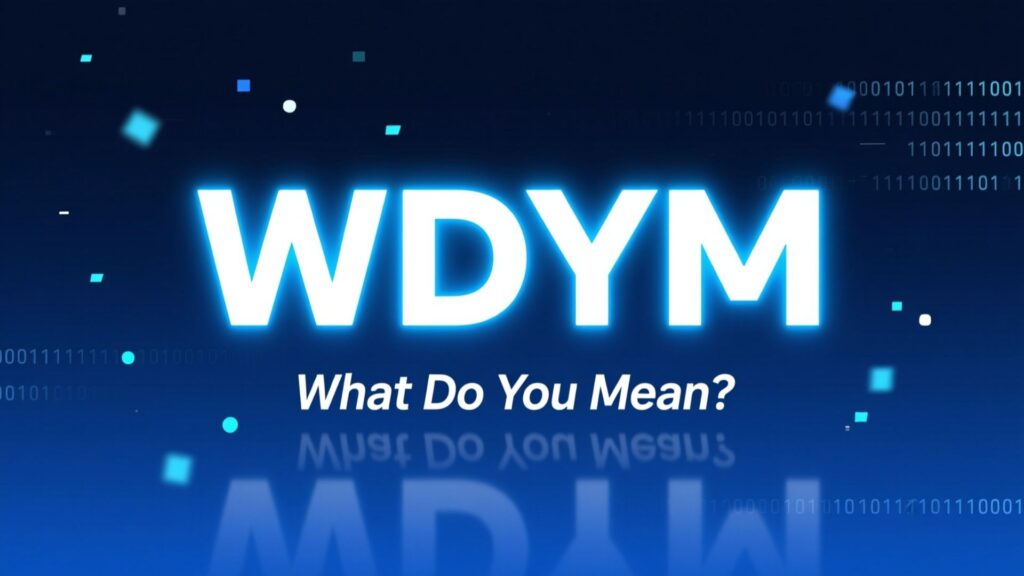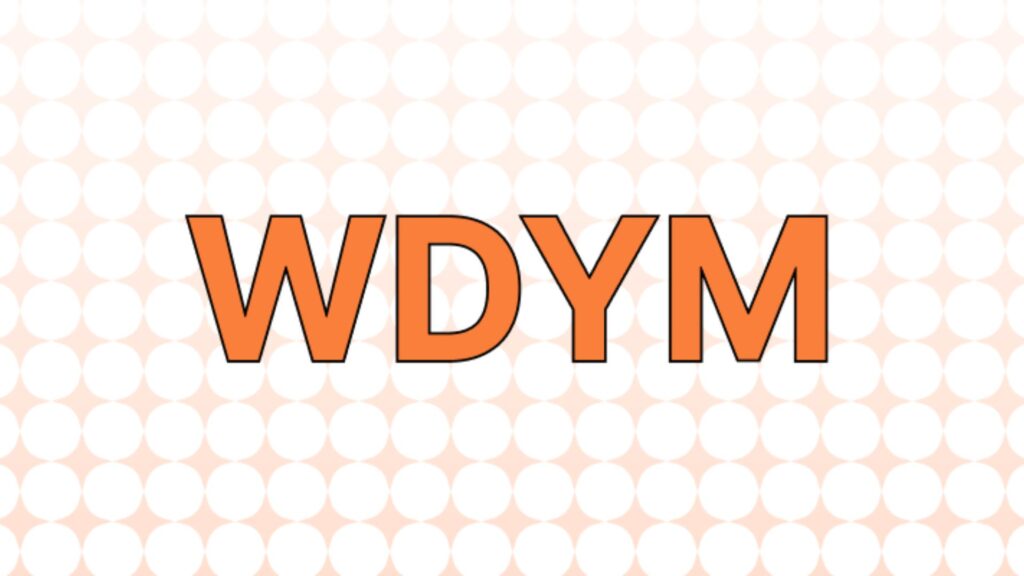Texting shorthand has become a staple in digital communication. One of the most commonly used acronyms is WDYM, but many people wonder what it really means and how to use it correctly. In this comprehensive guide, we’ll break down wdym meaning, explore its tone, context, alternatives, and show you exactly how to respond or use it in your own messages in 2025.
Quick Answer: WDYM Meaning in Text

At its core, WDYM stands for “What do you mean?”. It’s a concise way to ask someone to clarify a statement.
- Tone: Can range from neutral to playful or even slightly annoyed, depending on punctuation and context.
- Usage: Common in SMS, social media DMs, and instant messaging apps. Avoid formal emails or professional settings unless casual tone is established.
TL;DR: WDYM is shorthand for seeking clarification, helping keep conversations fast-paced and clear.
Origin and Evolution of WDYM
Like many text acronyms, WDYM meaning in text traces back to the early 2000s instant messaging platforms. Users wanted a quick way to ask for clarification without typing the full phrase.
- Origin: Instant messaging platforms like AOL Instant Messenger and MSN Messenger popularized the abbreviation.
- Evolution: From SMS texting to modern apps like WhatsApp, X, Instagram, and Threads, WDYM has remained relevant because brevity is crucial in chat.
- 2025 Usage: Still commonly used among teens, young adults, and casual workplace chats. Emojis and tone markers often accompany it to soften the message.
Precise Definition and Variants
WDYM is short for “What do you mean?”, but subtle variations exist:
| Variant | Context | Example |
|---|---|---|
| WDYM | Standard, neutral | Friend: “That’s weird.” You: “WDYM?” |
| wdym | Casual, lowercase | “wdym lol” |
| WDYM? | Clarifying, questioning tone | “WDYM? I don’t follow.” |
| wydm | Typo or variant | Rare, less common |
Key tip: Capitalization and punctuation dramatically affect tone. Adding a question mark often softens the message.
Tone Guide: How WDYM Reads in Practice
The same acronym can communicate different emotions. Here’s a practical tone matrix:
| Tone | Signals | When to Use | Example |
|---|---|---|---|
| Neutral | Simple clarification | Chat with friends or peers | “WDYM?” |
| Confused | Seeks explanation politely | Unclear instructions | “wdym? I’m lost” |
| Skeptical | Questioning statement | Debate or mild disagreement | “WDYM. Are you sure?” |
| Annoyed | Slight irritation | Misunderstood messages | “WDYM? This makes no sense.” |
| Playful | Light teasing or joking | Casual chats with friends | “WDYM lol 😆” |
Note: Tone depends on context, recipient, and punctuation. Emojis and phrasing can completely alter interpretation.
Platform and Audience Contexts
WDYM meaning in text changes slightly depending on the platform:
- SMS/Texting: Quick clarification works best, especially among friends.
- Instagram DMs: Often used with emojis or gifs to make tone playful.
- X/Twitter Threads: Rare but effective for responses under character limits.
- Slack/Teams: Use only with colleagues you know well; otherwise, prefer full phrasing.
- Email: Generally avoid WDYM in formal communication.
Audience matters: Friends, peers, and casual colleagues usually understand it. Older adults or non-native speakers may require the full phrase.
When WDYM is Appropriate
WDYM meaning in text is situational. Use it when:
- You need a quick clarification.
- The conversation is casual or fast-paced.
- The context allows for short abbreviations.
Avoid it:
- In formal professional emails.
- With unclear referents (don’t ask WDYM if it’s ambiguous what you’re referring to).
- When tone could be misinterpreted.
Rule of Thumb: If the message recipient might misread your tone, spell it out: “Could you clarify what you mean?”.
How to Write WDYM So Tone Matches Intent
Small changes in punctuation and capitalization dramatically affect interpretation:
| Style | Effect | Example |
|---|---|---|
| wdym? | Neutral, casual | “wdym? I don’t get it.” |
| WDYM | Skeptical, urgent | “WDYM. That’s confusing.” |
| WDYM? 😊 | Playful, friendly | “WDYM? 😊” |
| Sorry, wdym? | Polite, soft | “Sorry, wdym? Can you explain?” |
Adding context, emojis, or polite language ensures your tone is perceived correctly.
What to Say Instead: Smart Alternatives
Sometimes WDYM may feel abrupt. Here’s a categorized table of practical alternatives:
| Category | Phrase | Best Use Case | Example |
|---|---|---|---|
| Neutral/Concise | What do you mean? | Everyday chat | “What do you mean by that?” |
| Polite/Formal | Could you explain that further? | Work or formal messaging | “Could you explain that further?” |
| Friendly/Casual | Huh, what do you mean? | Friends, light tone | “Huh, what do you mean lol?” |
| Professional | Can you expand on this point? | Workplace discussion | “Can you expand on this point for clarity?” |
| Clarifying Specifics | Do you mean X or Y? | Ambiguous statements | “Do you mean project A or project B?” |
| Tentative/Probing | Are you saying that…? | Soft questioning | “Are you saying that we need to redo this task?” |
| Fast Chat | Say what? | Quick casual response | “Say what? 😅” |
Tip: Choose the alternative that matches tone and audience to avoid miscommunication.
How to Respond When Someone Says WDYM to You

When someone uses WDYM meaning in text with you, respond clearly to maintain smooth conversation flow.
Steps:
- Acknowledge the request.
- Restate your point.
- Give an example if needed.
- Confirm understanding.
Casual reply:
“Oh, I meant that the movie starts at 7, not 6. Hope that clears it up!”
Workplace reply:
“Thanks for asking! I meant that the Q3 report needs revision before Friday. Does that make sense?”
Common Mistakes and Misreads
Even short acronyms can backfire. Avoid:
- Aggressive tone: Writing WDYM in caps with no context can seem rude.
- Public misusage: Avoid in group chats with diverse audiences.
- Ambiguity: Using WDYM when it’s unclear what you refer to.
Quick fix: Always accompany WDYM with a clarifying statement or emoji to soften tone.
Accessibility and Inclusivity
Acronyms like WDYM can unintentionally exclude some readers:
- Non-native speakers may not understand.
- Neurodivergent readers may misinterpret tone.
- Older audiences may not recognize shorthand.
Recommendation: Use full phrases in mixed groups or when clarity is critical. Screenshots or alt text should spell out WDYM for accessibility.
Professional and Legal Considerations
In professional environments:
- Avoid WDYM in performance reviews, official communications, or HR discussions.
- Document clarifications in emails or project management tools for records.
- Use polite alternatives: “Could you clarify your point?”
This prevents misinterpretation and maintains professionalism.
Tone Troubleshooting Flowchart
A visual guide can help decide whether to use WDYM:
Decision path:
- Audience: friend, peer, colleague, superior.
- Platform: chat, DM, email, social media.
- Urgency: quick clarification needed?
- Potential offense: could tone be misread?
Action: If any red flag appears, spell it out instead of using WDYM.
Examples Bank: Real-World Dialogue Snippets
Friend Chat:
- Friend: “I can’t believe he said that.”
- You: “WDYM?”
- Alternative: “Wait, what exactly did he say?”
Romantic Chat:
- Partner: “I don’t think you get me.”
- You: “wdym?”
- Alternative: “I want to understand. Can you clarify?”
Coworker Chat:
- Colleague: “We need to redo the presentation.”
- You: “WDYM?”
- Alternative: “Could you expand on which slides need revisions?”
Group Chat:
- Message: “This approach won’t work.”
- You: “WDYM?”
- Alternative: “Can someone explain why it won’t work?”
Customer Support:
- Client: “Your update broke the system.”
- You: “WDYM?”
- Alternative: “Can you describe the exact issue you’re seeing?”
SEO and On-Page Optimization Tips
To rank for wdym meaning and related keywords:
- Use H1, H2, H3 naturally with keywords like what does wdym mean in text.
- Add structured FAQ schema.
- Use internal links to related articles (texting etiquette, workplace communication).
- Include short example snippets for featured snippets.
Images, Diagrams, and Assets
Visuals enhance clarity:
- Tone matrix table
- Flowchart for WDYM usage
- Example conversation screenshots (redacted for privacy)
Alt text examples:
- “Tone matrix showing WDYM meaning in text across different tones”
- “Flowchart guiding WDYM usage for professional vs casual chats”
FAQ Section
What does WDYM mean?
- It stands for “What do you mean?”, used for clarification.
Is WDYM rude?
- Not inherently. Tone and context matter. Caps without context can seem harsh.
How do you respond to WDYM professionally?
- Restate your point clearly and politely, e.g., “I meant that the report needs revision.”
Can I use WDYM at work?
- Only in casual chats with colleagues you know well. Avoid formal communication.
What are polite alternatives to WDYM?
- “Could you clarify?”; “I’m not sure I follow”; “Can you expand on that?”
Closing Summary and Practical Cheat-Sheet
Recap: WDYM is a handy, concise way to ask for clarification. Use it with attention to tone, platform, and audience. When in doubt, spell it out.
Quick Cheat-Sheet:
| Situation | WDYM Style | Alternative |
|---|---|---|
| Casual chat | wdym? | What do you mean? |
| Confused/friendly | WDYM 😊 | Huh, what do you mean? |
| Professional | Avoid WDYM | Could you clarify? |
| Skeptical/urgent | WDYM | Are you saying that…? |
| Quick clarification | WDYM | Say what? |
Using WDYM meaning in text correctly improves clarity, strengthens relationships, and keeps your chats flowing effortlessly.
Bugti is the founder of Quoethint.com, a hub for English language tips, writing advice, and grammar guidance. With years of experience in English studies and a passion for clear communication, Bugti created this platform to make grammar and writing easy to understand for everyone.
